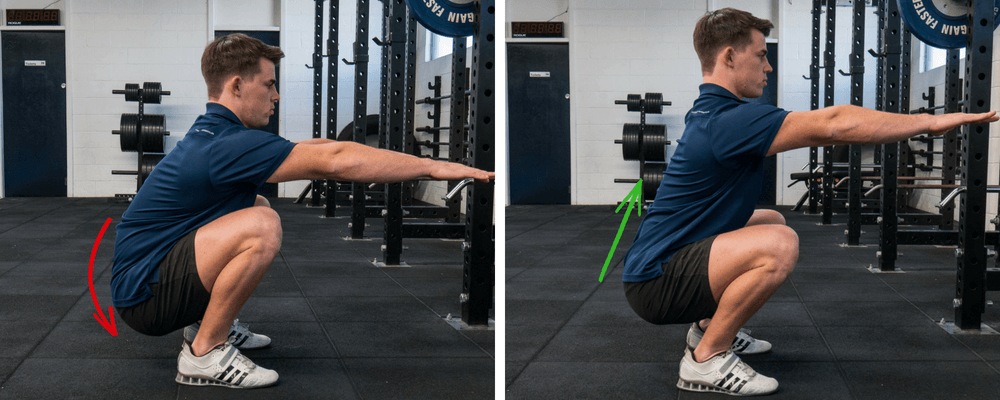One of the most discussed topics in strength sports is squat depth. Should you go parallel or just beyond parallel? Or preferably all the way with your ass to the ground (ass to grass, ATG)? The answer to this question may surprise you.
You may think that we are going to advise you to squat parallel or as deep as possible. However, we do not recommend either. We advise you to make your squat depth dependent on the curve of your back.
For the record: parallel means to the point where your knee and hip joints are at the same height. But if you’re a powerlifter, the tops of your knees should be just above your hips.
FORM BEFORE ROM
During squats, there is enormous pressure on your vertebrae and intervertebral discs. It is therefore important to keep your back as straight as possible while performing each exercise, especially during the (heavy) squat. A non-straight back when squatting or deadlifting is the quickest way to a hernia or other serious injury that will keep you out of the gym for weeks or months.
If you’re an avid squatter, you’ll know that at some point in the move it’s practically impossible to go deeper without arching your back: the so-called butt wink.
 Especially if you use heavy weights, the butt wink can lead to serious back problems. (Source: Movement Enhanced )
Especially if you use heavy weights, the butt wink can lead to serious back problems. (Source: Movement Enhanced )For some, this is ‘just’ a biomechanical impossibility. Others have to do with limited hip or ankle flexibility and (ergo) limited mobility of that joint. If the latter is the case, there are various stretching exercises to increase your flexibility and mobility and thus squat deeper while maintaining a straight back.
So even though parallel squats aren’t officially full-ROM squats, it’s important that you perform the exercise correctly and (therefore) safely. If you can do that in parallel, but not beyond parallel, let alone ATG, then the choice is clear.
SQUAT DEPTH AND EFFECTIVENESS
The squat is a knee-dominant movement and the amount of movement in that joint partly determines the effectiveness of the exercise. A bend of approximately 90 degrees in your knee joint provides your quadriceps with sufficient incentive to grow.
EMG EXAMINATION
In 2002, an EMG study showed that the full squat activates the gluteus maximus, or buttocks, more than the parallel squat. If you mainly aspire to a firmer butt, that could be an argument to go to the grass with that same butt. Side note: in this study, all three squat shapes (partial, parallel, and full) used the same weight. And that while you can perform parallel squats more heavily than full ones.
In a similar study, from 2016, in which the weight was adjusted to the squat form (relative loading), no differences in muscle activation between the different squat forms – neither in the buttocks nor in other muscle groups were found. Viewed from this point of view, it would make no difference to muscle growth whether you squat parallel or deeper, provided you adjust the intensity accordingly (ie do more reps or use more weight).
BIOMECHANICAL RESEARCH
However, EMG studies are not always reliable indicators of muscle growth and/or strength gain. For example, a 2020 biomechanical study found that deep squats are excellent butt builders: they were more than twice as effective for gluteal muscle growth as the hip thrust, considered by many coaches to be the glut exercise. So this was not an EMG study, but an actual measurement of muscle growth after a twelve-week training program.
The researchers attribute the results to the large ROM in which the buttocks are stimulated during deep squats, while the ROM for hip thrust is relatively small. The fact that hip thrusts have the highest peak activation of the buttocks, according to several EMG studies, does not appear to be of decisive importance in practice.
Parallel squats probably stimulate the glutes less well, thinks coach Menno Henselmans, who subjected the research to an analysis.
It is quite possible that deeper squats also stimulate the quadriceps more, although we cannot conclude that from EMG studies. But because you can then use a less high weight, you may end up with an equivalent growth stimulus on balance. So if you don’t think the glutes are that important, there doesn’t seem to be a good reason to go deeper than parallel.
If you especially want to size up your glutes, the full squat may be a must. Although you can of course still go a long way with the hip thrust.
OTHER BENEFITS OF DEEP SQUATS
If you can squat deeper – in a correct way – or even go ATG, that in itself is a nice achievement. It requires full range of motion on all four major weight-bearing joints of the body (the ankles, knees, hips and shoulders) and good mobility through the spine. Deep squats are a way to train your flexibility and mobility. Squatting with your butt (almost) until to the ground also allows you to use the stretch reflex and spring up from the bottom position.
In addition, if you do the ATG squat correctly (not an insignificant condition), it may even be better for your knees than the parallel squat. Because, simply put, the more you bend the knees (so the deeper your squat), the less pressure there is in the knees.
CONCLUSION
To train the quadriceps, the primary target muscle of the barbell squat, it is enough to squat to parallel. If you squat deeper, ATG if desired, the glutes in particular seem to benefit.
If you squat deeper than parallel, make sure your back stays straight into bottom position. You may lack the flexibility and mobility to safely squat this deep. Then you are just taking an unnecessary risk. Therefore, when in doubt: squat to parallel.